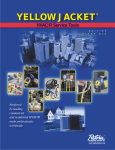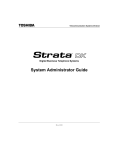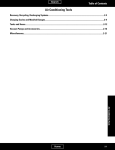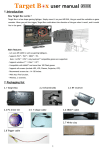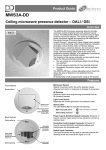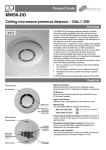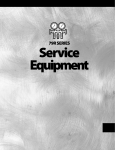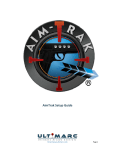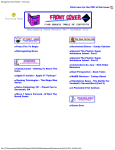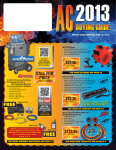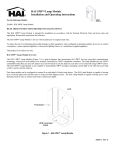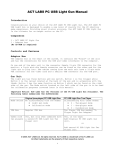Download YELLOW JACKET Leak Monitors and Portable Detectors — locate
Transcript
YELLOW JACKET Leak Monitors and Portable Detectors — locate problems fast and save money IMPROVED AccuProbe Leak Detector page 84 UPDATED Leak Monitoring Information page 92 83 YELLOW JACKET ACCUPROBE™ LEAK DETECTOR – heated sensor and Smart Alarm™ to find every leak fast and 1 1 6 99 sure, and know how big Building on the field-proven original, this improved unit is the only tool you need for fast, easy, and certain leak detection. The heated sensor tip of the YELLOW JACKET® ACCUPROBE™ Leak Detector positively identifies the leak source for all refrigerants even those that other detectors miss. That includes HCFCs as small as 0.03 oz./yr.; HFC leaks of 0.06 oz./yr., even R-404A and R-410A; and CFCs (R-12 and R-502). 1 to 3 = less than 0.1 oz/yr 4 to 6 = 0.1 to 0.5 oz/yr 7 to 9 = more than 0.5 oz/yr Lightweight for handling comfort. 2-year limited warranty (1-year warranty on sensor). LED Smart Alarm™ Indicator Low battery indicator (4 AA alkaline) Sensitivity levels Audible alarm mute Sensor not poisoned by large amount of refrigerant and does not need recalibration. Sensitivity adjust Made in USA ON/OFF Flashing tip Audible beeping (can be muted) Soft-touch grip AC adapter jack (adapter included) 18” reach Frequency of flashes in the tip and audible beeping increases the closer you get to the leak source. You zero-in and the exclusive Smart Alarm™ LED shows how big or small the leak on a scale of 1 to 9. Maximum value helps you determine if the leak needs immediate repair. Service life of the replaceable heated electrochemical sensor is more than 300 hours with minimal cleaning and no adjustments. Replaceable filters help keep out moisture and dust that can trigger false sensing and alarms. Independent of the Smart Alarm LED, the unit combines three sensitivity levels with visual and audible signalling, including ultra-high to detect leaks that could be missed with other detection systems. 84 • Sensor not poisoned by large amounts of refrigerant • Position probe for close-up or extended 18" detection • Lightweight for handling comfort • Replaceable filters help keep out dust and moisture • Sensor failure mode • Automatic calibration (no manual recalibration) • Leak Standard bottle of non-ozone depleting chemical included to verify proper functioning of sensor and electronic circuitry • 2-year limited warranty (1-year warranty on sensor) Unit is preset at normal sensitivity, but you can switch to high or low. If there is no response from the flashing tip or beeping signal at normal sensitivity in the general area of a suspected leak, select high sensitivity. This will detect even low levels in the general area and confirm your suspicions. Use low sensitivity as you move the tip over more defined areas of a system, and you will be alerted when the tip encounters the concentration at the leak source. The frequency of flashing from the heated sensor tip increases as you get closer to a leak and refrigerant concentration increases. You can also turn on the audible alert. Beeping increases in frequency and duration as concentration increases. Technology Comparison – Heated Sensor or Negative Corona? Tips for detecting system leaks 1. Inspect entire A/C system for signs of oil leakage, corrosion cracks, or other damage. Follow the system in a continuous path so no potential leaks are missed. Heated Sensor Leak Detectors When the heated sensing element is exposed to refrigerant, an electrochemical reaction changes the electrical resistance within the element causing an alarm. The sensor is refrigerant specific with superior sensitivity to all HFCs, HCFCs, and CFCs and minimal chance of false alarms. When exposed to large amounts of refrigerant which could poison other systems, the heated sensor clears quickly and does not need recalibration before reuse. 2. Make sure there is enough refrigerant in system (about 15% of system capacity or 50 psi min.) to generate pressure to detect leaks. 3. Check all service access port fittings. Check seals in caps. Negative Corona Leak Detectors 4. Move detector probe at 1" per second within 1/4" of suspected leak area. In the sensor of an old-style corona detector, high voltage applied to a pointed electrode creates a corona. When refrigerant breaks the corona arc, the degree of breakage generates the level of the alarm. This technology has good sensitivity to R-12 and R-22, but only fair for R-134a, and poor for R-410A, R-404A, and R-407C. Sensitivity decreases with exposure to dirt, oils and water. And false alarms can be triggered by dust, dirt specks, soap bubbles, humidity, smoke, small variations in the electrode emission, high levels of hydrocarbon vapors, and other non-refrigerant variables. 5. Refrigerant is heavier than air so position probe below test point. 6. Minimize air movement in area to make it easier to pinpoint the leak. 7. Verify an apparent leak by blowing air into suspected leak to clean the area and see if the leak remains.. 8. When checking for evaporator leaks, check for gas in condensate drain tube. Specifications Max sensitivity : 0.06 oz. (1.7 g)/yr. HFC’s R-134a Max sensitivity : 0.03 oz. (0.9 g)/yr. HCFC’s R-22 9. Use heated sensor type detector for difficult-to-detect R-134a, R-410A, R-407C, and R-404A. Heated semiconductor sensor: Over 300 hours life Affected by humidity: No Response time: Very fast Body length: 10 inches (25.4 cm) Probe length: 18 inches (46 cm) Weight: 20 ounces (0.6 L) Warm up time: 25 seconds or less Battery type continuous life: 4 AA alkaline, 8 hours Operating temp. range: 24° to 110°F (-4° to 43°C) Storage temp range: -4° to 122°F (-20° to 50°C) UPC# Description 69365 69366 69367 69368 69378 69380 69381 69382 Heated AccuProbe Heated AccuProbe European Heated AccuProbe Japan Heated AccuProbe Australia/New Zealand (std w/69368) AC Adapter 230V/50-60 Hz (std w/69365) AC adapter – 115V/60 Hz (std w/69366) AC adapter – 230V/50 Hz (std w/69367) AC adapter – 100V/50-60 Hz Accessories and Parts 69383 69384 69385 69386 69387 69388 69389 Kit – sensor, filters and bottle Replacement sensor and filter Package 5 sensor filters Leak sensor bottle Carrying case with inserts Carrying holster with clip Battery cover and screw Alarm (with mute) Illuminated bar graph 17" probe for extended reach Made in USA Hand-held precision equipment detects all hydrocarbon and other combustible gases including propane, methane, butane, industrial solvents, and more. See page 91 for details. Approvals : SAE J1627, CE 85 LEAK DETECTION MONITORS Maintenance required: No YELLOW JACKET COMBUSTIBLE GAS DETECTOR – with ultra-sensitive, long life sensor Fluorescent Leak Detection – pinpoint leaks at the speed of light. AC&R Leaks Leaks usually start small and grow. When you find a leak early while still small, it’s easier and faster to repair, and you save expensive refrigerant. Whether the system runs continuously or only part time, dye solution is ready in the system 24 hours a day to help you find even the smallest leaks with a lightweight UV lamp. Automotive Leaks 69790 Automotive manufacturers are installing dye in their A/C systems during assembly to make it easier for service technicians to pinpoint leak sources. Dye is always readily visible with a UV beam. With YELLOW JACKET ® Fluorescent Leak Scanners, you start by injecting solution into the system. No need to steam or clean area before scanning. Once the solution circulates, leak sources glow in the beam of the UV lightgun. It’s that fast and simple. • Accurate – The source of every leak glows, even leaks 1/4 oz. per year • Reliable – See leaks indoors or outdoors. There are no problems with halide odors, noxious gases, or false alarms. Seeing and fixing every leak saves you the time of no-charge rework, reduces emissions and helps meet regulations • Versatile – Easy-to-use with all AC&R systems and refrigerant oils • Long lasting – Works for years • Energy saving – A system with a full charge runs more efficiently With refrigerant loss, a system can use 25-50% more electricity • See exact leak location • Harmless to the system, recovery units, and the environment • Find leaks more quickly and from a greater distance than electronic detection Benefits of Fluorescent Scanning • Lightweight, small and easy to carry • Find previously undetected leaks Fluorescent Scanning Applications Put the technology to work wherever you find AC or refrigeration systems: • A/C splits to window units • Commercial refrigeration from supermarket to small cabinets • Property management such as packaged terminal A/C units • Centrifugal systems including marine refrigeration and A/C • Industrial hydraulic systems and closed loop water systems refrigeration • Chillers • Transportation refrigeration • Automotive transmissions, cooling system, and A/C YELLOW JACKET MICRO LED UV LEAK DETECTION KITS Use these high visibility lamps to spot leaks on all A/C systems. Individual reflectors surround each of five LEDs recessed for protection in the stainless steel head. 69790 features 3 UV and 2 blue bulbs A/C for detection at greater distances. For greatest contrast with all fluorescent dyes, use 69791 with 5 UV bulbs. 86 • 110,000+ hour LEDs • Constant ON or momentary ON switch • Sealing locks out moisture • Long life lithium battery included • Aircraft aluminum body • Limited lifetime warranty Continued on next page. Kit Lamp only YELLOW JACKET 3.2 and 2-Watt LED Flashlights UNIVERSAL PURE UV ™ SYSTEM Universal is your best choice for all dye bases including mineral, AB, PAG, POE, engine, and lubricant. UPC# Description 69797 Instant on – no warm up. 69773 69796 Compact 3.2-watt unit delivers 85 lumens for up to 250' effective range and up to 2-hour continuous nondimming illumination (40 lumens for up to 175' and 5 hours with 2 watt unit). Patented technology combines special high quality lens and reflector to emit only pure UV light (330-380 nanometers). Efficient in close quarters with power similar to AC lamps. Filter glasses not required. 69770 69771 69772 69773 69775 69777 69410 69418 69413 Pure UV – flashlight, adapter and case Pure UV – 90° adapter and case Pure UV – 90° transformer and case Pure UV – 90° battery/charger and case Pure UV – 90° AC/R master kit w/transformer, A/C dye, coolant dye, oil dye, adapter hose and case Pure UV – 90° lamp – 230V with case Replacement bulb Filter lens Filter holding ring MINI UV BLUE SYSTEM Features for both include: • Coolant, oil, and fluid dyes • Durable carrying case • Use with battery pack or AC transformer • One piece lens that focuses and projects up to 90% of light in a uniformly circular beam • Aircraft aluminum body with military grade, Type III anodized finish and sure-grip texture • Compression sealed for water resistance Micro LED High Intensity Lamp Illuminates 120' away with 5 high intensity clear bulbs. Visible at one mile. Carrying pouch Clear bulbs • 110, 000+ hour LEDs Compact flashlight with patented Dichrolic filter produces bright UV Blue light for maximum output in its class. Kit includes: • Lamp with 65W bulb and UV glasses • A/C dye syringes plus delivery hose for HVAC/R and auto systems 69740 UPC# Description 69740 69741 69742 69419 69423 Mini ni lamp, glasses, clip adapter gl Mini lamp above with case Mini lamp above with A/C, oil and coolant dyes, delivery hoses and case UV Blue lens – 2" Bulb for mini LEAK DETECTION MONITORS • Individual reflectors surround each of 5 LEDs recessed for protection in a stainless steel head 69742 • Lithium battery for over 20 years of light and 10-year shelf life UPC# Description 69796 2 watt LED flashlight 69797 3.2 watt LED flashlight 69787 Micro 5 UV LED kit for ACR 69788 Micro UV LED and dye kit for auto 69789 Micro UV LED and dye kit for ACR 69790 Micro UV LED lamp 3 UV bulbs-2 blue bulbs 69791 Micro Pure UV LED lamp 5 UV bulbs 69792 Micro LED lamp clear bulbs for general use 69793 Replacement pouch for LED 69794 Lithium battery Accessories Common Parts UPC# Description 69409 Carrying/storage case 69401 69403 69405 69406 Battery with case and charger Battery only Fast/trickle charger only AC power transformer 69415 Fluorescent viewing glasses for greatly enhanced visibility 87 YELLOW JACKET® UNIVERSAL A/C DYE INJECTORS AND HOSE Universal A/C dye injectors work in AC/R and auto A/C systems. Four 1/4 oz. applications of dye in each disposable tube make it economical, fast and clean. Hose features back flow check valve. UNIVERSAL A/C DYE SOLUTIONS UPC# Description 69702 69703 69705 69706 Hose plus 2 injectors for AC/R Auto R-134a hose, coupling & injectors Injector hose with SealRight™ Auto R-134a injector hose & service coupler CALIBRATED A/C SCREW INJECTION to A/C low side and rotate handle. AC/R and auto models. This 2-ounce injector is easy to refill and easy to operate. Calibrations are clearly marked on the injector. Connect UPC # Description 69730 69731 Calibrated A/C screw injector Auto R-134a calibrated A/C screw injector with service coupler Auto R-134a calibrated A/C screw injector without service coupler 69732 DYE AND OIL INJECTORS • Put oil in after changeout • Add scanner fluorescent solution • Add additives to system • Refrigerant sampling Body and cap are rugged aluminum with an O-ring seal. 1/4" male fitting at one end with Schrader. A ball valve for control on other end with a short length of hose. Valve depressor in 1/4" female end. 600 psi working pressure. UPC# Description 69559 1/4 oz. oil injector 69560 1/2 oz. oil injector 69561 2 oz. oil injector 69562 4 oz. oil injector 69563 “O”- ring 1/4 and 1/2 oz. injector (5 pk) Saves time on many applications: 69564 “O”- ring 2 & 4 oz. injector (5 pk) • Add oil to system For auto injectors see page 112. LARGE SYSTEM INJECTORS – systems with up to 32 gallons of lubricant Self contained injection system for inducing up to 8 oz. of universal AC&R dye into the largest systems. Add to the low side. Easily works on all system pressures to 300 PSI, 1.5 oz. per stroke. Hose included with SealRight® end. UPC # Description 69555 77950 Large system injector Large system injector with coupler DYE APPLICATION AMOUNTS Application System size in lbs. of refrigerant Universal dye amount Small appliance A/C or refrigerant systems Larger systems up to 4.9 lbs. (2.22 kg) up to 25 lbs. (11.34 kg) above 25 lbs. (11.34 kg) .25 0z. (7.5 ml) .5 oz (15 ml) .5 oz (15 ml) per gal. of oil Compatible with mineral, alkyl, ester and PAG oil systems. 88 Universal dye for A/C systems with mineral, alkyl, or polyol ester lubricants. • • • • Field proven and sold worldwide Passed thermal stability tests One dye for AC/R systems Raw material QC assures dye uniformity UPC# Description 69711 69708 69709 69710 69712 69713 69803 69805 69806 1/4 oz. (7.5 ml) universal A/C – 24/cs. 1/2 oz. (15 ml) universal A/C – 12/cs. 1 oz. (30 ml) universal A/C – 6/cs. 2 oz. (60 ml) universal A/C – 6/cs. 8 oz. (240 ml) universal A/C – 1/cs. 8 oz. (240 ml) universal A/C – 6/cs. 1 gal. (3.78 L) universal A/C – 1/cs. 5 gal. (18.92 L) universal A/C – 1/cs. 55 gal. (208.19 L) universal A/C – 1/cs. Oil/fluid and coolant dyes available on page 90. UNIVERSAL A/C DISPOSABLE INJECTORS Universal disposable 1 oz. applicator for fast economical dispensing. Universal dye for all common refrigerants and oils. Two 1/2 oz. applications for regular split systems or four 1/4 oz. applications for small appliances or auto A/C. oz .25 ml 7.5 oz .25 ml 7.5 .25 7.5 oz ml oz .25 ml 7.5 Easy to use: connect to system, push in plunger, and then disconnect. • Less costly and faster than many other methods • One dye minimizes inventory • No back-up refrigerant to move dye into system • Patented UPC# Description 69700 1 oz. (30 ml) injector – 6/cs. (12 residential applications/cs.) 69721 1 oz. (30 ml) injector – 2/pkg. (4 residential applications/pkg.) 69727 1 oz. (30 ml) injector – 1/pkg. YELLOW JACKET AC POWERED UV LAMP for high intensity, contrast, and ease of detection. Handle stays cool and vinyl-coated heat guard cage around the ring helps keep fingers away from the lens. Cage also provides a handy stand. Lightweight pistol-grip lamp with 10 foot cord plugs into any outlet. Metal housing and lens retention ring with break resistant lens protects the high output 160 watt bulb. Lens filters out virtually all light except pure UV and concentrates the beam like a spot light Kit includes light gun with AC cord, UV spot bulb with ballast, heat guard cage/stand, high contrast filter, and UV protective glasses. UPC # Description 69435 A/C leak scanner lamp kit 69436 Replacement UV bulb with ballast 69468 Replacement UV filter lens 69438 Heat guard lamp stand INSPECTION MIRRORS stainless telescoping FLUORESCENT LEAK SCANNER SYSTEM II 2. Connect high and low sides. Let high pressure gas move solution into the system while throttling refrigerant flow. 3. Add solution to the oil container and then pump solution into the system. Complete system includes: 3 simple ways to inject system 1. Use refrigerant from tank to move solution into low side while throttling refrigerant flow. • UL Listed UV lightgun with bulb, hand grip and heat guard. 110 volt • Mineral-based pre-filled fluorescent solution tubes with two bleed valves • SealRight™ Fitting immediately traps refrigerant in hose when disconnected • UV-absorbing anti-fogging goggles • Service manual and carrying case UPC # Description 69631 69632 69460 69461 69464 69466 69467 69468 69474 69498 18993 69470 69670 69671 Leak Scanner System II 120V Leak Scanner System II 230V Mist infuser 1/2 oz. Mist infuser 2 oz. Complete lightgun with bulb, stand Replacement UV bulb with ballast Heat guard/stand for new body Replacement UV filter lens UV-absorbing goggles Carrying case System control valve Rubber filter holder for lamp Bleed valve (1/4" SAE threads) Bleed valve (1/2" Acme threads) Mirror Check leaks in rotates hard to see places. 360° Stainless steel mirror on ball joint rotates Extend to 28" 360˚. Handle telescopes to 28". More mirrors page 111. UPC # Description 78100 Round 3 3/4" diameter 78101 Rectangular 3 3/4" x 2" 78102 Rectangular 2" x 1 1/4" CLEANERS Scan-off UV Cleaner Water-based biodegradable spray cleans scanner solution from system. LEAK DETECTION MONITORS With Scanner System II, you not only accurately pinpoint every leak at the speed of light, but also save prep time. High intensity UV lamp with filter produces almost pure UV to light up fluorescent particles in the solution for the best contrast and fastest, most visible results. Simply connect the disposable pre-filled solution injector tube directly to the AC&R system. There's no solution mess and you eliminate the cost and time of a separate infuser. UV detection as preventative maintenance Leaks generally start small. With ultra-violet leak scanners for system surveillance you can keep a small problem from becoming a bigger, more expensive one. After installing the correct dosage of Universal Dye solution, locate leaks quickly. The big payback comes on each subsequent visit. A quick scan of the system reports to you system status on all leaks, so you can repair even the smallest. Of course UV detection can also be used to confirm leaks and show the customer. Natural Degreaser Heavy-duty biodegradable degreaser removes scanner solution from system. Hand Cleaner Cleans solution from hands. UPC# Description Quantity 69698 Natural Degreaser #01020 19 oz. Indiv. 69699 Hand cleaner 16 oz. Indiv. 69696 Spray-off solution 8 oz. Indiv. 69697 Spray-off solution 8 oz. 12 /case 89 YELLOW JACKET FLUORESCENT SCANNER SOLUTIONS – technology to match refrigerant and system volume Different concentrations of Yellow Jacket fluorescent solutions are available to match the refrigerant volume in a system. You also have the choice of bottles for the original system or the disposable pre-filled solution injector tubes for System II. Injectors and bottles Systems up to 2.9 lbs. gas. 01 Systems with 1 to 4.9 lbs. gas. 1 Systems with 5 to 9.9 lbs. gas. 2 Operating temperature: -40°F for all solutions. Alkylbenzene in alkylbenzene systems to -100°F. Systems with 10 to 25 lbs. gas. 3* 4 Large systems use 1/4 oz. per gallon of oil in system. * When working on split systems, servicemen generally prefer to use solution 3 even if system has 10 lbs. of gas or less. Patented disposable pre-filled solution tubes. Self-infusing injector tubes Ester Alkylbenzene oil system system Bottles Solution concern System .size Mineral oil system PAG oil system Mineral 0il system Ester oil system Alkylbenzene system 01 (.03 oz.) up to 2.9 lbs. 69610 69620 69600 1 (.5 oz.) up to 4.9 lbs. 69611 69621 69601 69451 2 (.5 oz.) up to 9.9 lbs. 69612 69622 69602 69452 3* (.5 oz.) up to 25 lbs. 69613 69623 69603 4 (2 oz.) Large** 69454 4 (16 oz.) Large** 69624 69604 69455 69625 69605 69590 69453 * Use on all split systems. ** Only bottles are available for systems with over 75 lbs. of refrigerant. For large systems add 1/4 ounce #4 solution per gallon of oil. Injectors packaged 6/case. Bottles of solution 12/case. #4 solution individual bottles. AC&R bottles YELLOW JACKET FLUORESCENT SOLUTIONS for non-refrigerant applications Using your scanner system to help locate leaks in non-refrigeration and non-A/C applications adds value and versatility to your leak scanner system. The oil and fluid dye solution, and coolant H 2O dye solution, and H 2O auto solution all work similarly to the refrigerant scanner solution above. Pour in the appropriate amount of dye solution and use the UV lamp to find the bright glow. The oil and fluid dye solution is for finding leaks in oil-based applications such as milling machines and hydraulics, transmissions, power steering, and more. Use one ounce per 2 gallons of oil. 90 • Pin point leaks in hydraulic systems such as cherry pickers circulatory system or static system that can be pressurized or agitated • Find seal and gasket leaks in engines, compressors and transmissions • Locate leaks in gasoline or diesel fuel equipment, offset printing presses, injection-molding machines, locomotive engine oil coolers, and oil-cooled chillers 69584 H 2O solution glows blue at leak sources in large closed-loop water systems such as boilers and sprinklers. Use one pint per 1,000 gallons of water • Easiest way to detect leaks in storage tanks and other high volume containers, as well as associated piping, valves, condensers, sprinkler systems, pumps, etc. • Detect water leakage in any enclosed Bright blue glow Coolant dye to pinpoint leak sources in antifreeze-based automotive water systems such as hydronics and engine radiators. Use one ounce per each gallon of coolant. UPC# Description 69584 69733 69734 69735 69737 69738 69739 Fluorescent H2O solution, 16 oz. bottle 1 oz. (30 ml) oil and fluid dye – 6/cs. 1 oz. (30 ml) oil and fluid dye – 24/cs. 8 oz. (240 ml) oil and fluid dye – 1/cs. 1 oz. (30 ml) coolant dye – 6/cs. 1 oz. (30 ml) coolant dye – 24/cs. 8 oz. (240 ml) coolant dye – 1/cs. Frequently Asked Questions 1. Does the UV scanner light work better than an electronic leak detector? YELLOW JACKET Combustible Gas Detector – with ultra-sensitive, long life sensor No one detection system is better for all situations. But, with a UV lamp you can scan a system more quickly and moving air is never a problem. Solutions also leave a telltale mark at every leak site. Multiple leaks are found more quickly. Illuminated bar graph 2. How is the solution different from visible colored dyes? Unlike colored dyes, YELLOW JACKET ® fluorescent solutions mix completely with oil and do not settle out. Lubrication, cooling capacity and unit life are not affected. And there is no threat to valves or plugging of filters. The solutions will also work in a system containing Dytel. 3. In a system with a mix of mineral and alkylbenzene oil, which scanner solution should be used? Base your choice of solution on whatever oil is present in the larger quantity. If you don’t know which oil is in greater quantity, assume alkylbenzene. 4. How do I test the system? Put solution into a running system to be mixed with oil and carried throughout system. Nitrogen charging for test purposes will not work since nitrogen will not carry the oil. 5. What’s the most effective way to perform an acid test? Scanner solution affects the color of the oil slightly. Use a 2-step acid test kit which factors out the solution in the oil, giving a reliable result. 17" probe for extended reach Made in USA Hand-held precision equipment detects all hydrocarbon and other combustible gases including propane, methane, butane, industrial solvents, and more. Applications Sensitivity, bar graph, and beeping to signal how much and how close • Gas heaters • Manholes • Combustion appliances • Air quality Unit is preset at normal sensitivity, but you can switch to high or low. After warm-up you’ll hear a slow beeping. Frequency increases when a leak is detected until an alarm sounds when moving into high gas concentration. The illuminated bar graph indicates leak size. If no leak is detected in an area you suspect, select high sensitivity. This will detect even low levels in the area to confirm your suspicions. Use low sensitivity as you move the tip over more defined areas, and you will be alerted when the tip encounters the concentration at the leak source. • Ultra-sensitive sensor detects less than 15 ppm methane and better than 12 ppm for propane. Performs equally well on a complete list of detectable gases including acetylene, butane, and sobutane • Automatic calibration and zeroing YELLOW JACKET solutions meet or exceed applicable ASHRAE and ANSI tests. Meets SAE standard J2297 for R-134a UV leak detection. • Long life sensor easily replaced after full service life • 2-year limited warranty • And many more features • Gas lines/pipes • Propane filling stations • Hydrocarbon refrigerant • Heat exchangers • Marine bilges • Arson residue (accelerants) Specifications Response time: Instantaneous Warm up time: 10 seconds Power: 4 AA alkaline batteries Probe length: 17 inches (43.17 cm) Sensor life: 500 hours Body length: 10 inches (25.4 cm) Weight: 20 ounces (.057 kg) Battery life: 20 hours continuous Operating temp. range: Approvals: 32° to 110°F (0° to 43°C) Intrinsic Safety, CE UPC# Description 69373 69301 69371 69387 69388 Combustible gas detector w/case Sensing Tip Replacement sensor Carrying case – blow molded Carrying holster 69379 Battery cover red and screw 91 LEAK DETECTION MONITORS To confirm solution in the system, shine the lamp into the system's sight glass. Another way is to connect a hose and a sight glass between the high and low sides, and monitor flow with the lamp. The most common reason for inadequate fluorescence is insufficient solution in the system. Alarm (with mute) Three reasons to monitor 1. Safety and Legal ASHRAE 15-2001 safety code for mechanical refrigeration calls for refrigerant monitoring systems to be installed in machinery rooms, industrial occupancy buildings, and refrigerated rooms such as in factories, plants, processes, and high probability systems. Monitors that actuate an alarm and air ventilation are to be located in all areas where refrigerant from a leak could concentrate. Configure a YELLOW JACKET Fixed Monitoring System that’s right for you. Refrigerant or ammonia monitor In addition, an increasing number of local regulations govern occupational health and safety, refrigerant use, and fixed monitoring as a way to protect people from hazardous situations: • Refrigerants are not normally detected and can displace oxygen • Most refrigerants do not have an odor and exposure to flame generates toxic fumes 2. Economical With taxes and other factors driving up the costs of refrigerant, catching and repairing a leak early makes good economic sense. Fast detection and repair also protects your HVAC&R system, helping control maintenance and operating costs. With YELLOW JACKET ™ Fixed Monitoring Systems for refrigeration leaks, you can configure controllers and remote sensors to meet your requirements for point or perimeter detection. You can monitor most common refrigerants or ammonia. Controllers are available using one or two sensors (shown here) or four or six sensors (see page 94). The system first emits an intermittent siren and constant orange illumination at the low level, about 100 ppm. At the high level, usually about 1,000 ppm*, the siren is continuous and LED is red to signal a condition that requires immediate action. To help minimize false alarms, all systems wait until “certain” of gas in the air before signalling. Voltage-free relay switch can activate ventilation or remote alarms, or report to control systems. The system features two relays. Single sensor system Includes refrigerant monitor with refrigerant sensor or ammonia monitor with ammonia sensor. Refrigerant sensor Ammonia sensor controller circuitry is in a coated steel housing. The maintenance-free sensors are protected in a high impact ABS casing. All components are designed for long-life with mechanical strength and chemical resistance. Sensors will not be poisoned by prolonged exposure to refrigerant. Easy installation Systems are factory calibrated. Controllers and sensors mount to any flat vertical surface. For point detection, mount the sensor(s) near the most likely leak source. With perimeter detection, sensors surround the potential leak area. Sensors operate from -20° to 122°F (-29° to 50°C). From -20° to -40°F use with environmental enclosure, page 93. Typical two sensor, two level installation To help resist harsh work environments, 3. Environmental Refrigerants represent possible threat to the environment. And many refrigerants are toxic at various concentrations. Early detection and fast repair is common sense protection. 92 Applications • • • • • • Refrigerant storage areas Supermarkets Refrigeration machinery rooms Cold storage facilities Walk-in coolers Systems with large refrigerant volume • Marine and fishing fleets • Small deli stores, ice cream parlors, quick service stores. Semi-conductor technology provides a cost/performance balance that makes YELLOW JACKET systems an attractive alternative to electrochemical or infrared systems. * High levels: R-123 is about 300 ppm; ammonia about 150 ppm. Two sensor system Includes refrigerant monitor with refrigerant sensors or ammonia monitor with ammonia sensors. UPC # One and Two Sensor 120V Refrigerant Monitors UPC # 230V 68004 68104 68008 68091 Refrigerant or ammonia monitor Single sensor monitor with two level detection Two sensor monitor with two level detection Refrigerant sensor for two level monitor 68108 68191 UPC # One and Two Sensor 12V Refrigerant Monitors 68010 68011 Single sensor monitor with two levels of detection Two sensor monitor with two levels of detection — — One and Two Sensor Ammonia Monitors 68032 68036 Refrigerant sensors Ammonia sensors 68093 Single sensor monitor with two level detection Two sensor monitor with two level detection Ammonia sensor for two level monitor 68132 68136 68193 UPC # Accessories Refrigerant sensor is for most common CFCs, HFCs, and HCFCs, plus R-134a, R-404A, R-410A, R-407C, and R-123. Ammonia sensor is for ammonia only. 68096 68097 68099 500' alarm to sensor cable 1,000' alarm to sensor cable Monitor key switch set — — — Specifications Controller: 7.6" x 4" x 3"; 2.8 lbs. (193 x 102 x 76 mm; 1.3 kg) Relays: Dry contact switch; 10 Amp @ 120/250V max Sensor: 4.3" x 2.2" x 0.9" (109 x 56 x 23 mm) Operates to -20°F (29°C) Sensors can be hard wired up to 200' from controller ENVIRONMENTAL ENCLOSURE for sensors Two versions available: wall mount affixes to any surface and duct mount for sampling air inside plenum ducts. UPC # Description 68089 Environmental enclosure 68084 Duct mount enclosure Alarm 90 dB @ 18" (456 mm) Cable: 4-wire alarm with max 3.52 ohms/core/1000' Power: 120VAC, 60 Hz or 230VAC, 50/60 Hz Operation: Constant power-on and fault monitoring Reset: Automatic on one level unit. On two level unit, automatic on low level; manual on high level. MONITOR with 12 volt backup A single or two sensor, two level monitor that can be located up to 200 feet from the controller. UPC # 68010 and 68011. Integrated Area Monitor false alarms before signalling. Siren can be switched off. Sensor and controller are combined into a single, compact unit that can be hard wired into any outlet or power supply and detects leaks in the area. The unit emits a continuous siren and constant red LED illumination at about 1000 ppm. This early warning gives technicians time to find the leak while refrigerant concentration is still low. With adjustable delay, the monitor waits 0-5, 10 or 15 minutes to avoid Two voltage-free relays can activate ventilation or remote alarms, or report to control systems. Can also be connected to dedicated 16 unit panel. Expandable indefinitely by connecting control panels. Size: 3.4" x 5.8" x 2.4" (86 x 147 x 61 mm) Applications: living spaces, marine, and mechanical rooms. UPC # Description 68050 Integrated Area Monitor 115V 68051 Integrated Area Monitor 220/240V 68052 Control panel 115V 68053 Control panel 220/240V 93 LEAK DETECTION MONITORS A sensor element mounted in an area of high condensation, low temperature to -40°F, or direct airflow can experience a fast temperature drop causing a false alarm. These vented enclosures maintain the proper operating temperature around the sensor for alarm reliability. Power LED: Green YELLOW JACKET 4 AND 6 SENSOR MONITORING SYSTEMS YELLOW JACKET 4 and 6 sensor monitors provide all of the benefits of the 1 and 2 sensor systems (pages 92-93), but increase coverage area and level of coverage with more sensors at greater distances from the controller. Cost per channel are lower. You can locate 4 or 6 sensors up to 500' from the controller. UPC # 120V Refrigerant Monitors UPC # 230V 68016 Refrigerant four sensor monitor with two levels of detection 68116 68024 Refrigerant six sensor monitor with two levels of detection 68124 68091 Refrigerant replacement sensor for two level refrigerant monitor 68191 Specifications Controller: 10.3" x 10" x 3.2" (262 x 254 x 81 mm) 6.3 lbs. (2.9 kg) Relays: Dry contact switch; 10 Amp@120/250v max Power LED: Green Alarm: 10 dB @ 3 feet (92 cm) Sensor: 4.3" x 2.2" x 0.9" (109 x 56 x 23 mm) 0.2 lb. (0.1 kg) Cable: 4-wire alarm with maximum 8.8 ohms/core/1000 ft. Sensors can be hard wired up to 500' from controller Power: 120VAC, 60 Hz or 230 VAC, 60 Hz Operation: Constant power-on and fault monitoring Reset: Automatic on one level unit. On two level unit, automatic on low level; manual on high level Ammonia Monitors 68043 Ammonia four sensor monitor with two levels of detection 68143 68047 Ammonia six sensor monitor with two levels of detection 68147 68093 Ammonia replacement sensor for two level ammonia monitor 68193 See alarm cables on page 93. RELAY EXPANDER BOX Enables the 4 or 6 sensor controller to individualize response to each sensor. For example, sensor one is set to activate a fan and auto dialer while other sensors activate different response systems. If sensor one detects a leak, only its corresponding systems are activated. The other sensors remain in monitoring mode and will respond individually if a leak is detected in their specific area. Ribbon cable connects the relay expander box to the YELLOW JACKET controller. Typical Installation UPC # 120V Description UPC # 230V 68028 4 sensor expander box 68128 68029 6 sensor expander box 68129 UPC # 120V Hydrocarbon Monitors UPC # 230V 68064 Hydrocarbon monitor single sensor with two levels of detection 68164 68068 Hydrocarbon monitor two sensors with two levels of detection Hydrocarbon sensor for two level hydrocarbon monitors only 68168 COMBUSTIBLE REFRIGERANT (HYDROCARBON) GAS MONITORS The YELLOW JACKET hydrocarbon sensors will detect most hydrocarbons such as methane, butane, propane, and all other products emerging in refrigerant applications, including: Propane Propene Isobutane (R-290) (R-1270) (R-600a) Sensors are set at 100 ppm low level, and 1000 ppm for a high level alarm. 94 68094 68194 Guidelines on Locating Sensors • Do not mount in areas of high heat, direct solar heat, wetness, dampness, or where condensation may form on the sensor Ceiling • Do not mount to piping or any structure subject to vibration Improper location in boiler room 8"-12" (20-30cm) • For perimeter detection, place sensors around the area in question to monitor the entire space • For point detection, place a sensor(s) at a point where you are concerned about a leak, i.e. at the compressor 24"-36" (60-90cm) • For heavier than air gases, place sensors close to the ground Floor • To help prevent false alarms from stray gas particles such as Volatile Organic Compounds (VOCs), mount sensors 24" TO 26" from the floor Sensors must be powered according to the instruction manual and be within the cable length from the control unit. • For lighter than air gases, place sensors high on the walls or ceiling, but convenient for maintenance. Note: Ammonia is lighter than air at normal temperature but heavier in a cold room • Take room shape into consideration and mount sensors downstream of any air flow • In hot rooms, hot air rises to form a barrier below the ceiling and prevents gas from getting to a ceiling-mounted sensor Mount sensors out of traffic flow areas to prevent bumping. Contact Ritchie Engineering for detailed suggestions. Remote Systems Control System on Sealed area Installer supplied power source Sensor box Leak Monitor There are two major types of refrigerant monitoring systems – Fixed and infrared (IR). Following is a summary of the differences: Fixed monitoring System IR Systems Measures a broad band of most common CFCs, HFCs, and HCFCs, such as: R-11, R-12, R-13, R-22, R-113, R-123, R-134a, R-404A, R-407C, R-410A, R500, R-502 and R-507. A single sensor must be used for each specific refrigerant. Less than $500 per sensor to measure abroad range of refrigerants. $1000 and more per sensor for each refrigerant. Installation Controllers mount on any flat surface and then cable is run from the controller to the sensor(s). Plumbing tube is used to reach sensing points. An additional tube for exhaust is also required. Once you’ve chosen between a Fixed Monitoring System or an IR System for your application, you’ll have to evaluate the features that a monitor might include. • Flexibility is size of controls – Controllers available for 1, 2, 4 or 6 sensors allow you to buy what you need now and plan to expand in the future LEAK DETECTION MONITORS Cost All of these related products can be triggered by the monitor alarm. All are available from your local fire alarm or building management suppliers. Normally open/normally closed dry contact switches Evaluating Refrigerant Monitors Gases Measured Exhaust fan Emergency light Building monitor system Solenoid valve Autodialer Alarm System off • Two levels of response – A system can emit an intermittent alarm at a low level, about 100 ppm, indicating that maintenance is required, and a continuous siren at a high level, usually about 1000 ppm (R-123 high level is about 300 ppm) indicating that immediate action is required • Designed to minimize false alarms – Minimize false alarms by waiting until “certain” that gas is in the air before signaling • Individualized response by “zone” – Relay expander panel allows a 4 or 6 sensor system to be “zoned” for fast, individualized response in a larger application. If one sensor detects a leak, only its corresponding system is activated. The other sensors remain in monitoring mode • Sturdy protective housing – Coated steel housing for controller circuitry and ABS casing for sensors help protect the system and keep it maintenance-free • Protection in harsh environments – An optional vented environmental sensor enclosure protects a sensor that is mounted in an area of high condensation, low temperature to -40°F or direct airflow to avoid a false alarm 95 Frequently Asked Questions 1. Are calibrated leak testers available to confirm monitor is calibrated correctly? alarm. Metal oxide technology is proven for stability and performance detected at 7500 ppm. As with most refrigerants, the TWA is 1000 ppm. Ritchie Engineering does not sell calibrated leak testers, but gases for testing leak monitor installations are available through MSA Mine Safety Appliances, 121 Gamma Drive, Pittsburgh, PA 15238-2919. 1-800-672-2222 7. What is the detection sensitivity level of YELLOW JACKET fixed monitors? All of the foregoing suggests that for most CFC, HFC and HCFCs, detection at 1000 ppm provides a necessary safety margin for repair personnel. Ammonia with a significantly lower IDLH of 300 ppm and a TWA of 25 ppm requires detection at 150 ppm to comply with 50% IDLH requirements. R-123 has a TWA of 50ppm and an IDLH of 1000 ppm, therefore detection at 100 ppm provides a good margin of safety. 2. What refrigerants will the leak monitors detect? Leak monitors will detect most CFC, HFC, and HCFC’s. Such as R-11, R-12, R-13, R-22, R-113, R-123, R-134a, R-404A, R-407C, R-410A, R-500, R-502, and R-507. YELLOW JACKET also has leak monitors available for ammonia and hydrocarbon based refrigerants. The dual sensitivity system has a low alarm level of about 100 ppm and a high level of about 1000 ppm for most CFC, HFC, and HCFC products. The high level for R-123 is an exception at about 300 ppm. Ammonia detection levels are about 100 ppm low and about 150 ppm high. The alarm level of all YELLOW JACKET single level systems is about 100 ppm. Detection levels are preset at the factory to cover most situations. If necessary, however, you can order a custom level, or adjust the set point on site. A monitor with a detection threshold of about 100 ppm for any gas provides an early warning so that repairs can be made quickly. This can save refrigerant, money and the environment. 9. Will the system need recalibration? 8. What concentration must be detected? 3. Can the leak monitor be calibrated for specific applications? Yes, the YELLOW JACKET leak monitor can be calibrated for specific applications. Contact customer service for your specific need. 4. If the unit goes into alarm, can it switch on the fan? Can it turn off the system at the same time? The leak monitor has a pair of dry, normally open/normally closed contacts that can handle 10 amps at 115 volts. When the sensor indicates a gas presence higher than the set point, it opens the closed contacts and closes the open contacts which will turn equipment on or off. 5. After a unit goes into alarm and the contacts close, what can it be connected to? The open contacts can shut the system down, call a phone number, turn on a fan or emergency light, etc. 6. How does the sensor work? When the sintered metal oxide surface within the sensor absorbs gas molecules, electrical resistance is reduced in the surface allowing electrons to flow more easily. The system controller reads this increase in conductivity and signals an 96 Depends on the refrigerant. For a more thorough answer, terms established by U.S. agencies must first be understood: • IDLH - Immediately Dangerous to Life and Health • TWA – Time Weighted Average concentration value over an 8-hour work day or a 40-hour work week. (OSHA or NIOSH levels). • STEL – Short Term Exposure Level measured over 15 min. (NIOSH). • Ceiling Concentration (c) which should not be exceeded in a working day (OSHA). Obviously, the first consideration is IDLH. For most refrigerants, the IDLH is relatively high (e.g. R-12 is 15,000 ppm), and such a concentration would be unusual in a typical refrigerant leak situation. Leak detection, however, is still an immediate condition, so the STEL should be the next consideration, followed then by the 8-hour TWA or Ceiling Concentration. R-22, for example, has a STEL of 1250 ppm and a TWA of 1000 ppm.(The TWA for most refrigerants is 1000 ppm). The draft UL standard for leak monitors requires gas detection at 50% of the IDLH. In other words, R-12 with a IDLH value of 15,000 ppm must be Factory calibration should be adequate for 5-8 years. Routine calibration is unnecessary when used with intended refrigerants. YELLOW JACKET sensors can not be poisoned, show negligible drift, and are stable long term. You should, however, routinely check performance. 10. Can there be a false alarm? For monitoring mixtures, the semiconductor must be able to respond to molecularly similar gases. With such sensitivity, false alarms can be possible. Engineered features in YELLOW JACKET monitors help minimize false alarms: • The two level system waits about 30 seconds until “certain” that gas is present before signalling. • At about 100-1000 ppm calibration level, false alarms are unlikely. To prevent an unnecessary alarm, turn off the unit or disable the siren during maintenance involving refrigerants or solvents. Temperature, humidity, or transient gases may occasionally cause an alarm. If in doubt, check with us.














